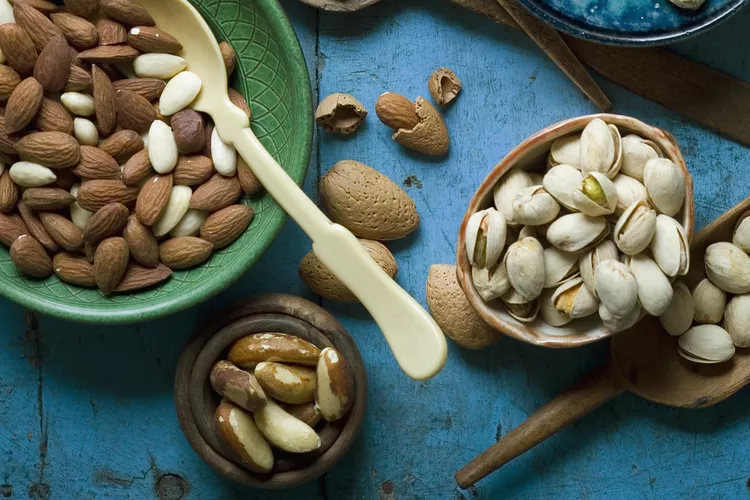
Known for their delicious flavor, snackability, and versatility in all kinds of recipes, nuts are staples in the home kitchen. They can be added to baked goods, tossed in savory preparations, or simply eaten by the handful. Nuts can also last a while if you know how to store them properly. While all nuts are beneficial for health, certain varieties come out on top. To learn more, we asked nutritionists about the best nuts to eat.
If almonds had a claim to fame, it would be their fiber content. Compared to other tree nuts, raw almonds offer the most fiber, which is key for healthy digestion, blood cholesterol, and blood sugar, according to Candace Pumper, MS, RD, CSOWM, LD, registered dietitian at The Ohio State University Wexner Medical Center. They’re also an excellent source of vitamin E and magnesium, which fight oxidative stress and support muscle function, respectively, says Daniela Novotny, RD, registered dietitian and senior instructor at the School of Health Sciences at Missouri State University.
“In the U.S., folks only eat about 50 percent of the recommended amount of magnesium daily,” so adding almonds to your diet can help boost your intake, adds Novotny.
How to Eat Almonds
For an elegant dinner, toss toasted almonds with linguine and your favorite sauce.
Add extra crunch and protein to meat dishes, as seen in our recipe for turkey meatballs in apricot sauce with mint and almonds.
Use almond flour to make gluten-free pancakes.
Crush the nut and mix with flour, figs, and butter to make homemade almond crackers.
Macadamia Nuts
Macadamia nuts are higher in monounsaturated (“good”) fats compared to other nuts, says Novotny. These fats can improve cholesterol levels and reduce blood pressure, potentially benefiting the heart. The buttery nuts are also high in manganese, which is needed for bone health, and copper, which benefits the skin and nervous system, per Connie Elick, RD, registered dietitian and instructor of plant-based culinary arts at the Institute of Culinary Education in Los Angeles.
How to Eat Macadamia Nuts
For a filling dinner, coat fish or chicken with macadamia nuts, suggests Elick.
Bulk up homemade vegan granola bars with chopped macadamia nuts.
Pair a handful of macadamia nuts with a piece of fruit for a balanced, fiber-rich snack, says Elick.
“Add chopped macadamia nuts to yogurt, cottage cheese, stir-fry, or salad,” recommends Elick.
“Pistachios are a unique type of nut, as they’re a great source of potassium while being a bit higher in protein than some other nuts,” says Novotny. This makes them a great source of plant-based protein for those who eat a vegan or vegetarian diet, notes Elick. You might also be surprised to learn that pistachios have a high content of melatonin, a hormone that regulates the body’s circadian rhythm (i.e., internal clock) and sleep patterns, notes Pumper.
How to Eat Pistachios
Puree pistachios with Greek yogurt to create a green-hued sauce, then serve with roasted butternut squash and grain relish.
Sprinkle chopped pistachios on eggplant and pomegranate pizza for a surprising twist.
Add a pop of color to your next dark chocolate bark with chopped pistachios.
Make a tasty pistachio salad by tossing the nut with vegetables and herbs.
Brazil Nuts
Brazil nuts are one of the highest sources of selenium, an essential mineral, and antioxidant, says Pumper. (In fact, just one Brazil nut per day will provide your recommended daily intake of selenium, says Novotny.) Selenium is key because it supports immunity, thyroid function, and reproductive health, according to Pumper. What’s more, the large nuts are rich in magnesium, copper, zinc, fiber, and vitamin E, all of which are needed for optimal health.
How to Eat Brazil Nuts
Though rare, it is possible to develop selenium toxicity from eating too many Brazil nuts. With that in mind, it’s best to eat no more than three Brazil nuts per day (and only enjoying them occasionally), says Pumper.
Chop them up and use in place of pine nuts in pesto.
Enjoy with fresh fruit or a piece of dark chocolate.
Top ice cream, yogurt, or cottage cheese with chopped roasted Brazil nuts.
Walnuts
While all nuts provide beneficial fat for the body, the fat content of walnuts is particularly impressive. Compared to other nuts, they boast the highest amount of omega-3 fatty acids, which have anti-inflammatory benefits for the heart, says Elick. “They also play a role in brain and eye function,” she adds. So much so that walnuts are considered to be one of the best foods for brain health—an easy fact to remember when you note that the nut looks like the brain!
How to Eat Walnuts
Serve walnuts with roasted Brussels sprouts and grapes for a unique side dish.
Make spiced walnuts for a tasty snack or grazing board component.
Toss chopped walnuts in chicken salad for a satisfying crunch.
Add walnuts to banana muffins or banana bread.
Pecans
Pecans are one of the best nuts to eat thanks to their diverse nutritional profile, which includes fiber, vitamin E, healthy fats, and essential nutrients like magnesium, phosphorous, and calcium. Together, these nutrients offer antioxidant and anti-inflammatory benefits for the body, according to Pumper.
How to Eat Pecans
Roast pecans with herbs for a flavorful and crunchy snack.
Use pecans in place of croutons in soups, stews, or salads.
Enhance the mashed sweet potatoes with a garnish of toasted pecans.
Enjoy chopped pecans in our oat chocolate cookies. They bring extra flavor, nutrition, and texture.
Copied Martha Stewart







